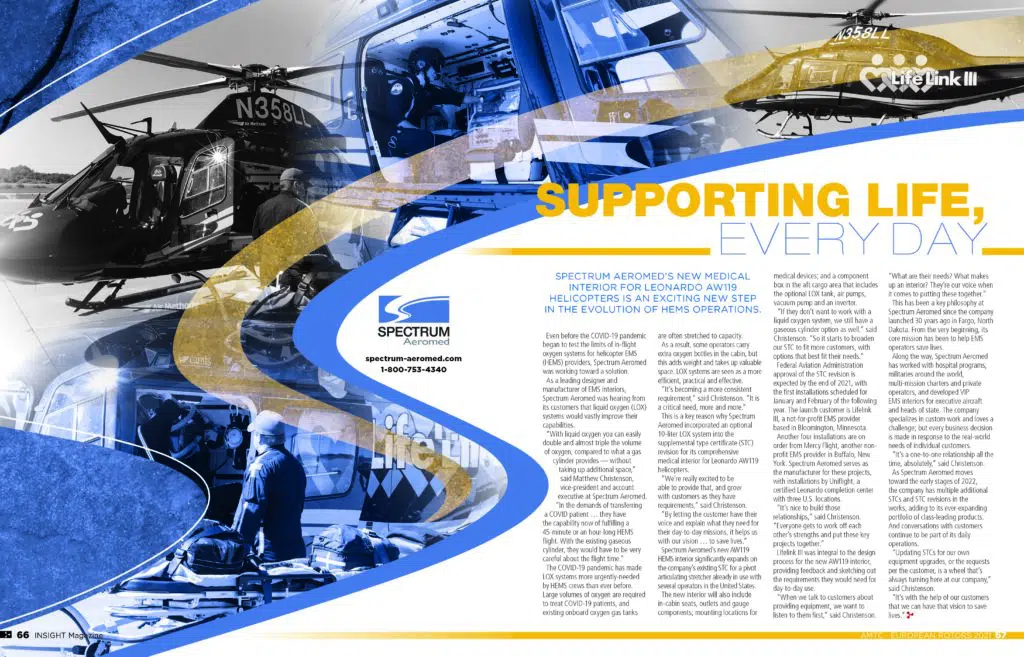AMTC – European Rotors 2021
Insight Magazine.
Even before the COVID-19 pandemic began to test the limits of in-flight oxygen systems for helicopter EMS (HEMS) providers, Spectrum Aeromed was working toward a solution.
As a leading designer and manufacturer of EMS interiors, Spectrum Aeromed was hearing from its customers that liquid oxygen (LOX) systems would vastly improve their capabilities.
“With liquid oxygen you can easily double and almost triple the volume of oxygen, compared to what a gas cylinder provides — without taking up additional space,” said Matthew Christenson, vice-president and account executive at Spectrum Aeromed.
“In the demands of transferring a COVID patient … they have the capability now of fulfilling a 45-minute or an hour-long HEMS flight. With the existing gaseous cylinder, they would have to be very careful about the flight time.”
The COVID-19 pandemic has made LOX systems more urgently needed by HEMS crews than ever before. Large volumes of oxygen are required to treat COVID-19 patients, and existing onboard oxygen gas tanks are often stretched to capacity.
As a result, some operators carry extra oxygen bottles in the cabin, but this adds weight and takes up valuable space. LOX systems are seen as a more efficient, practical and effective.
“It’s becoming a more consistent requirement,” said Christenson. “It is a critical need, more and more.”
This is a key reason why Spectrum Aeromed incorporated an optional 10-liter LOX system into the supplemental type certificate (STC) revision for its comprehensive medical interior for Leonardo AW119 helicopters.
“We’re really excited to be able to provide that, and grow with customers as they have requirements,” said Christenson.
“By letting the customer have their voice and explain what they need for their day-to-day missions, it helps us with our vision … to save lives.” Spectrum Aeromed’s new AW119 HEMS interior significantly expands on the company’s existing STC for a pivot articulating stretcher already in use with several operators in the United States.
The new interior will also include in-cabin seats, outlets and gauge components; mounting locations for medical devices; and a component box in the aft cargo area that includes the optional LOX tank, air pumps, vacuum pump and an inverter.
“If they don’t want to work with a liquid oxygen system, we still have a gaseous cylinder option as well,” said Christenson. “So it starts to broaden our STC to fit more customers, with options that best fit their needs.”
Federal Aviation Administration approval of the STC revision is expected by the end of 2021, with the first installations scheduled for January and February of the following year. The launch customer is Lifelink III, a not-for-profit EMS provider based in Bloomington, Minnesota.
Another four installations are on order from Mercy Flight, another nonprofit EMS provider in Buffalo, New York. Spectrum Aeromed serves as the manufacturer for these projects, with installations by Uniflight, a certified Leonardo completion center with three U.S. locations.
“It’s nice to build those relationships,” said Christenson.
“Everyone gets to work off each other’s strengths and put these key projects together.”
Lifelink III was integral to the design process for the new AW119 interior, providing feedback and sketching out the requirements they would need for day-to-day use.
“When we talk to customers about providing equipment, we want to listen to them first,” said Christenson.
“What are their needs? What makes up an interior? They’re our voice when it comes to putting these together.”
This has been a key philosophy at Spectrum Aeromed since the company launched 30 years ago in Fargo, North Dakota. From the very beginning, its core mission has been to help EMS operators save lives.
Along the way, Spectrum Aeromed has worked with hospital programs, militaries around the world, multi-mission charters and private operators, and developed VIP EMS interiors for executive aircraft and heads of state. The company specializes in custom work and loves a challenge; but every business decision is made in response to the real-world needs of individual customers.
“It’s a one-to-one relationship all the time, absolutely,” said Christenson.
As Spectrum Aeromed moves toward the early stages of 2022, the company has multiple additional STCs and STC revisions in the works, adding to its ever-expanding portfolio of class-leading products. And conversations with customers continue to be part of its daily operations.
“Updating STCs for our own equipment upgrades, or the requests per the customer, is a wheel that’s always turning here at our company,” said Christenson.
“It’s with the help of our customers that we can have that vision to save lives.”

